Nobel-winning technique like "Google Earth for molecules"
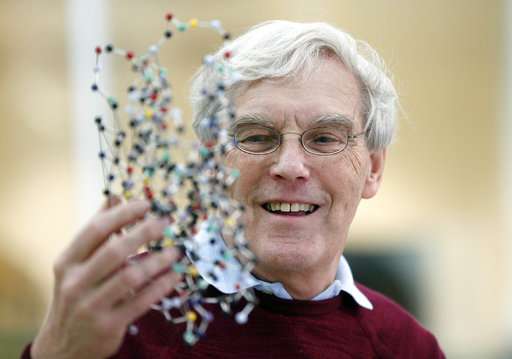
Three researchers won a Nobel Prize on Wednesday for developing a microscope technique that lets scientists see exquisite details of the molecules that drive life—basically providing a front-row seat to study these tiny performers in their biological dance.
The Royal Swedish Academy of Sciences said molecules can be captured down to the level of their atoms, and snapshots can catch them in mid-movement. That can help reveal how they interact.
"This method has moved biochemistry into a new era," the academy said in awarding its chemistry prize to Switzerland's Jacques Dubochet of the University of Lausanne, German-born U.S. citizen Joachim Frank at New York's Columbia University, and Briton Richard Henderson of MRC Laboratory of Molecular Biology in Cambridge, England.
The detailed images may pave the way for developing new medicines, vaccines and industrial chemicals, but experts said such payoffs are largely in the future.
"This is a technique that is just starting to find its way into the research community," said Allison A. Campbell, president of the American Chemical Society. It was recently used to reveal the structure of the Zika virus.
The method is called cryo-electron microscopy. It's like "Google Earth for molecules," Campbell said, because it "allows the scientist to zoom in down to the fine detail (giving) that fine resolution that you want to have."

Other methods have been used before to determine structures of some biological molecules, but they run up against fundamental limitations. The three winners of the $1.1 million (9 million kronor) prize adapted another technique, electron microscopy, which uses a beam of electrons rather than ordinary light to inspect samples.
Between 1975 and 1986, Frank developed mathematical models to turn fuzzy two-dimensional images into sharp, three-dimensional ones. Henderson, in 1990, was able to generate a three-dimensional image of a protein at atom-level resolution, showing the technology's potential, the Nobel committee said.
Dubochet, in the early 1980s, found a way to cool the water in a biological sample so quickly that it solidified without forming the ice crystals that can disrupt the electron beam.
Those early advances were followed by others that have greatly improved the technique, the Nobel committee said.
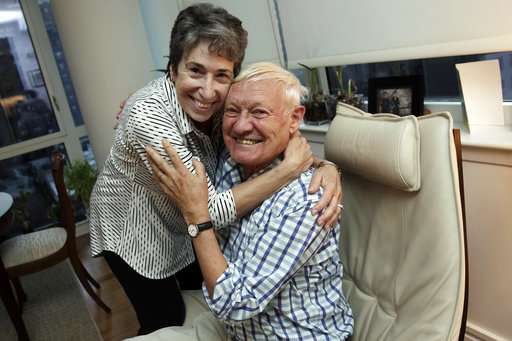
"It's the first time that we can see biological molecules in their natural environment and how they actually work together down to the individual atoms," said Nobel chemistry committee member Heiner Linke.
Henderson said Dubochet "kicked off the field; he invented this method of making specimens we now use."
Speaking to reporters in Cambridge, England, Henderson also said he felt "the three of us have been awarded the prize acting on behalf of the entire field."
Frank said he was "fully overwhelmed" and speechless upon hearing he had won a share of the prize.
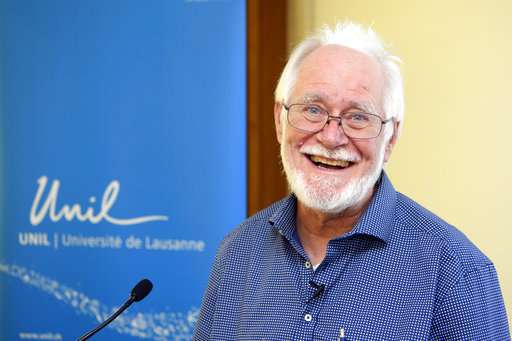
"I thought the chances of a Nobel Prize were minuscule because there are so many other innovations and discoveries that happen almost every day," he said.
He said he hasn't yet thought about what to do with the prize money, but added: "I was telling my wife that we don't have to worry about a dog sitter anymore."
The chemistry prize was the third Nobel announced this week.
The medicine prize went to three Americans studying circadian rhythms: Jeffrey C. Hall, Michael Rosbash and Michael W. Young. The physics prize went to Rainer Weiss, Barry Barish and Kip Thorne for detecting gravitational waves.
The literature winner will be named Thursday and the peace prize will be announced Friday.
-
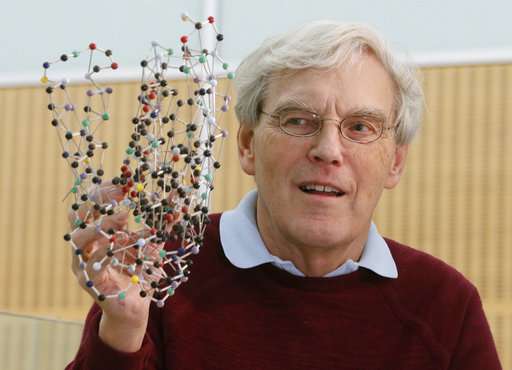
Richard Henderson, one of the 2017 Nobel Prize winners in Chemistry, holds a bacterio rhodopsin model prior to a press conference at the Laboratory of Molecular Biology in Cambridge, England, Wednesday, Oct. 4, 2017. Three researchers based in the U.S., U.K. and Switzerland won the Nobel Prize in Chemistry on Wednesday for developments in electron microscopy. The 9-million-kronor ($1.1 million) prize is shared by Jacques Dubochet of the University of Lausanne, Joachim Frank at New York's Columbia University and Richard Henderson of MRC Laboratory of Molecular Biology in Cambridge, Britain. (AP Photo/Frank Augstein) -
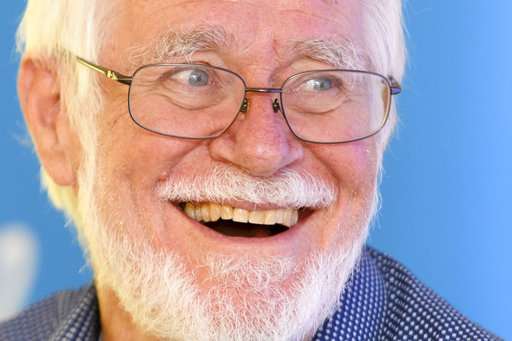
Jacques Dubochet, University of Lausanne, one of the 2017 Nobel Prize winners in Chemistry speaks during a press conference at the University of Lausanne, Unil, in Lausanne Switzerland, Wednesday, Oct. 4, 2017. Three researchers based in the U.S., U.K. and Switzerland won the Nobel Prize in Chemistry on Wednesday for developments in electron microscopy. The 9-million-kronor ($1.1 million) prize is shared by Jacques Dubochet of the University of Lausanne, Joachim Frank at New York's Columbia University and Richard Henderson of MRC Laboratory of Molecular Biology in Cambridge, Britain. (Jean-Christophe Bott/Keystone via AP) -
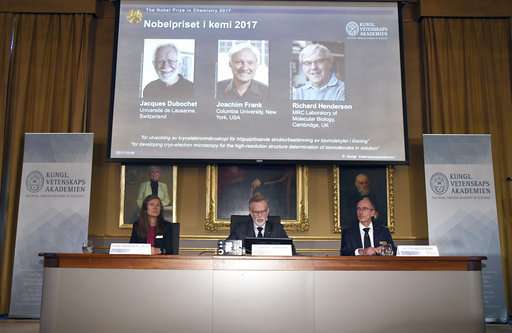
From left, Sara Snogerup Linse, chairman of the Nobel Committee in Chemistry, Goran K. Hansson, secretary of the Royal Academy of Sciences, and Peter Brzezinski, member of the Nobel Committee, sit during a press conference as they announce - Jacques Dubochet - from the University of Lausanne, Switzerland, Joachim Frank from Columbia University, USA and Richard Henderson, from the MRC Laboratory of Molecular Biology, Cambridge, in England as the winners of the 2017 Nobel Prize in Chemistry, at the Royal Academy of Sciences in Stockholm, Wednesday, Oct. 4, 2017. The Nobel Prize for Chemistry rewards researchers for major advances in studying the infinitesimal bits of material that are the building blocks of life. (Claudio Bresciani/TT News Agency via AP) -
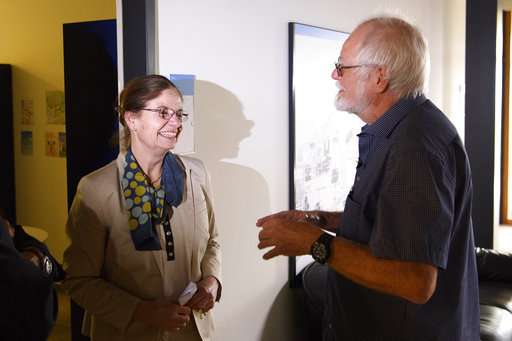
Jacques Dubochet, right, University of Lausanne, one of the 2017 Nobel Prize winners in Chemistry speaks next to Nouria Hernandez, left, Rector of UNIL after press conference at the Universitiy of Lausanne, UNIL, Switzerland, Wednesday, Oct. 4, 2017. Three researchers based in the U.S., U.K. and Switzerland won the Nobel Prize in Chemistry on Wednesday for developments in electron microscopy. The 9-million-kronor ($1.1 million) prize is shared by Jacques Dubochet of the University of Lausanne, Joachim Frank at New York's Columbia University and Richard Henderson of MRC Laboratory of Molecular Biology in Cambridge, Britain. (Jean-Christophe Bott/Keystone via AP) -

Joachim Frank, of Columbia University, takes a phone call in his New York City apartment, Wednesday, Oct. 4, 2017. Frank shares this year's Nobel Chemistry Prize with two other researchers for developing a method to generate three-dimensional images of the molecules of life. (AP Photo/Richard Drew) -
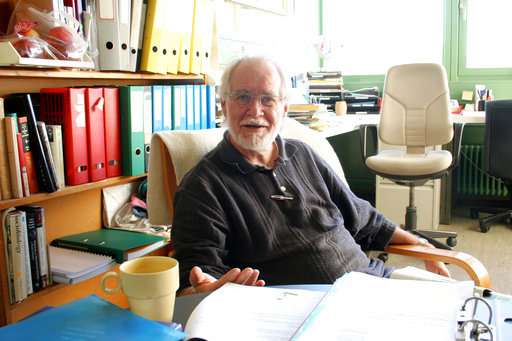
In this picture released by the University of Lausanne, Switzerland, Jacques Dubochet, chemistry professor at the University of Lausanne (UNIL), poses in his office, in Lausanne, Switzerland, in 2006. Three researchers based in the U.S., U.K. and Switzerland won the Nobel Prize in Chemistry on Wednesday Oct. 4, 2017 for developments in electron microscopy. The 9-million-kronor ($1.1 million) prize is shared by Jacques Dubochet of the University of Lausanne, Joachim Frank at New York's Columbia University and Richard Henderson of MRC Laboratory of Molecular Biology in Cambridge, Britain. (University of Lausanne/Keystone via AP) -
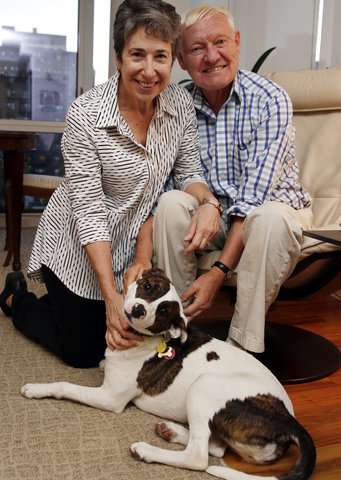
Joachim Frank, of Columbia University, poses for a photo with his wife Carol Saginaw, and their dog Daisy, in their New York City apartment, Wednesday, Oct. 4, 2017. Frank shares this year's Nobel Chemistry Prize with two other researchers for developing a method to generate three-dimensional images of the molecules of life. (AP Photo/Richard Drew) -
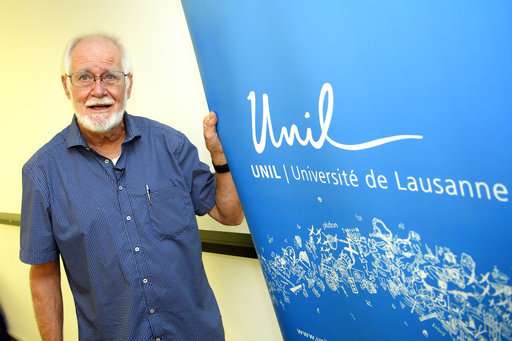
Jacques Dubochet, University of Lausanne, one of the 2017 Nobel Prize winners in Chemistry poses prior to a press conference at the University of Lausanne, Unil, in Lausanne Switzerland, Wednesday, Oct. 4, 2017. Three researchers based in the U.S., U.K. and Switzerland won the Nobel Prize in Chemistry on Wednesday for developments in electron microscopy. The 9-million-kronor ($1.1 million) prize is shared by Jacques Dubochet of the University of Lausanne, Joachim Frank at New York's Columbia University and Richard Henderson of MRC Laboratory of Molecular Biology in Cambridge, Britain. (Jean-Christophe Bott/Keystone via AP) -
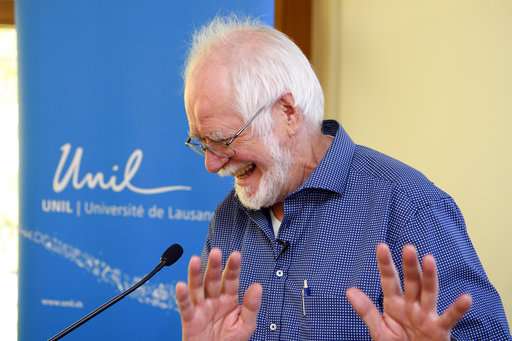
Jacques Dubochet, University of Lausanne, one of the 2017 Nobel Prize winners in Chemistry jokes prior to a press conference at the University of Lausanne, Unil, in Lausanne, Switzerland, Wednesday, Oct. 4, 2017. Three researchers based in the U.S., U.K. and Switzerland won the Nobel Prize in Chemistry on Wednesday for developments in electron microscopy. The 9-million-kronor ($1.1 million) prize is shared by Jacques Dubochet of the University of Lausanne, Joachim Frank at New York's Columbia University and Richard Henderson of MRC Laboratory of Molecular Biology in Cambridge, Britain. (Jean-Christophe Bott/Keystone via AP) -
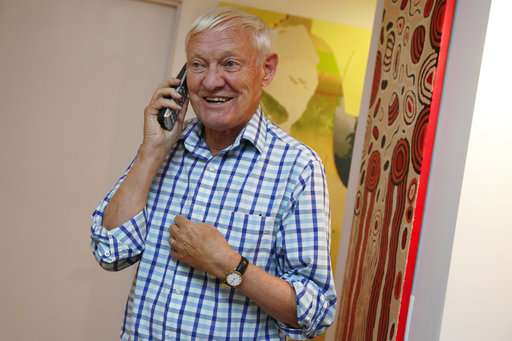
Joachim Frank, of Columbia University, takes a phone call in his New York City apartment, Wednesday, Oct. 4, 2017. Frank shares this year's Nobel Chemistry Prize with two other researchers for developing a method to generate three-dimensional images of the molecules of life. (AP Photo/Richard Drew) -
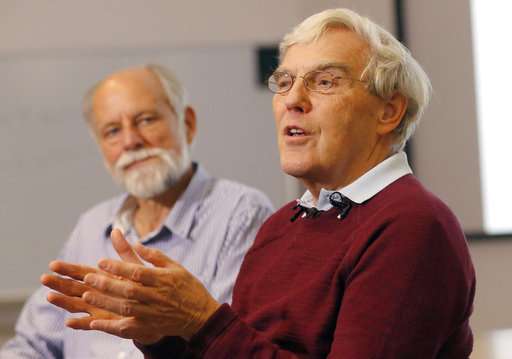
Richard Henderson, one of the 2017 Nobel Prize winners in Chemistry, speaks during a press conference beside director Sir Hugh Pellham at the Laboratory of Molecular Biology in Cambridge, England, Wednesday, Oct. 4, 2017. Three researchers based in the U.S., U.K. and Switzerland won the Nobel Prize in Chemistry on Wednesday for developments in electron microscopy. The 9-million-kronor ($1.1 million) prize is shared by Jacques Dubochet of the University of Lausanne, Joachim Frank at New York's Columbia University and Richard Henderson of MRC Laboratory of Molecular Biology in Cambridge, Britain. (AP Photo/Frank Augstein) -
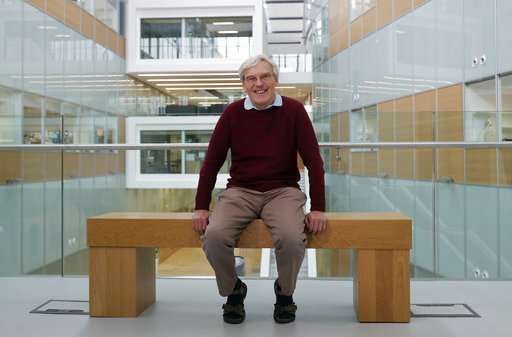
Richard Henderson, one of the 2017 Nobel Prize winners in Chemistry, reacts to photographers prior to a press conference at the Laboratory of Molecular Biology in Cambridge, England, Wednesday, Oct. 4, 2017. Three researchers based in the U.S., U.K. and Switzerland won the Nobel Prize in Chemistry on Wednesday for developments in electron microscopy. The 9-million-kronor ($1.1 million) prize is shared by Jacques Dubochet of the University of Lausanne, Joachim Frank at New York's Columbia University and Richard Henderson of MRC Laboratory of Molecular Biology in Cambridge, Britain. (AP Photo/Frank Augstein) -
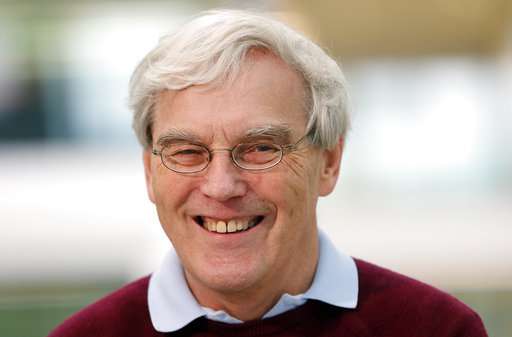
Richard Henderson, one of the 2017 Nobel Prize winners in Chemistry, smiles prior to a press conference at the Laboratory of Molecular Biology in Cambridge, England, Wednesday, Oct. 4, 2017. Three researchers based in the U.S., U.K. and Switzerland won the Nobel Prize in Chemistry on Wednesday for developments in electron microscopy. The 9-million-kronor ($1.1 million) prize is shared by Jacques Dubochet of the University of Lausanne, Joachim Frank at New York's Columbia University and Richard Henderson of MRC Laboratory of Molecular Biology in Cambridge, Britain. (AP Photo/Frank Augstein) -
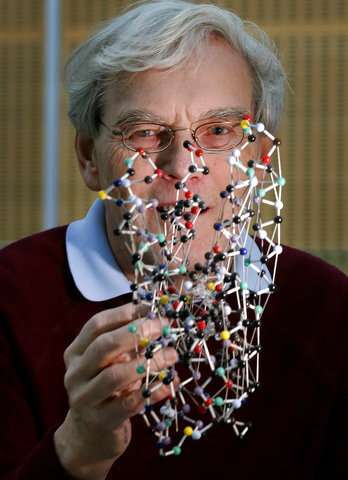
Richard Henderson, one of the 2017 Nobel Prize winners in Chemistry, holds a bacterio rhodopsin model prior to a press conference at the Laboratory of Molecular Biology in Cambridge, England, Wednesday, Oct. 4, 2017. Three researchers based in the U.S., U.K. and Switzerland won the Nobel Prize in Chemistry on Wednesday for developments in electron microscopy. The 9-million-kronor ($1.1 million) prize is shared by Jacques Dubochet of the University of Lausanne, Joachim Frank at New York's Columbia University and Richard Henderson of MRC Laboratory of Molecular Biology in Cambridge, Britain. (AP Photo/Frank Augstein) -
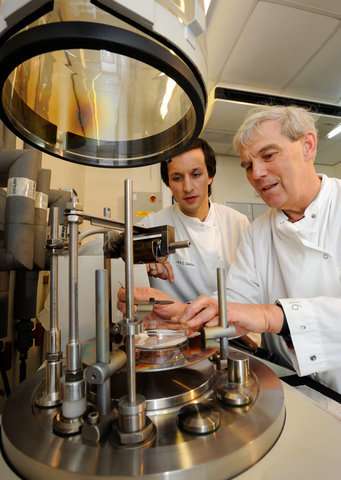
In this undated photo provided by the MRC Laboratory of Molecular Biology (LMB) in Cambridge, Richard Henderson, right and Carsten Sasche at work in a laboratory. Three researchers based in the U.S., U.K. and Switzerland won the Nobel Prize in Chemistry on Wednesday, Oct. 4, 2017 for developing a way to create detailed images of the molecules that drive life—a technology that the Nobel committee said allowed scientists to visualize molecular processes they had never previously seen. The 9-million-kronor ($1.1 million) prize is shared by Jacques Dubochet of the University of Lausanne, Joachim Frank at New York's Columbia University and Richard Henderson of MRC Laboratory of Molecular Biology in Cambridge, Britain. (Laboratory of Molecular Biology via AP) -
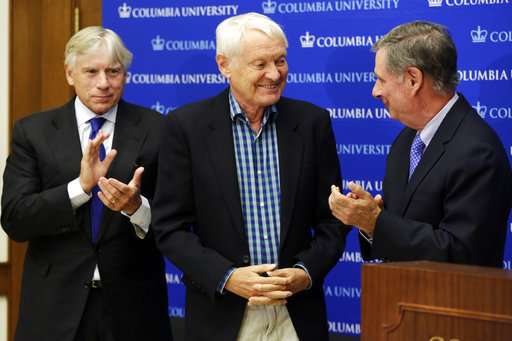
Joachim Frank, center, is applauded by President Lee Bollinger of Columbia University, left, and Lee Goldman, Chief Executive of the Columbia University Medical Center, as he's introduced at a Columbia University press conference, Wednesday, Oct. 4, 2017, in New York. Frank shares this year's Nobel Chemistry Prize with two other researchers for developing a method to generate three-dimensional images of the molecules of life. (AP Photo/Richard Drew) -
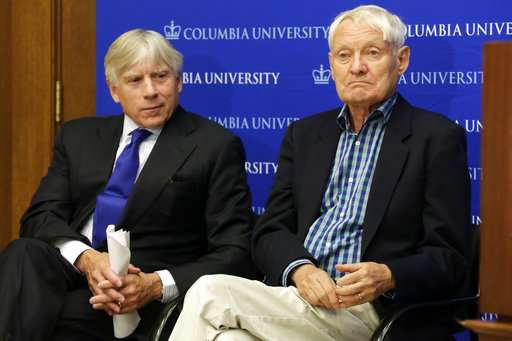
Joachim Frank, right, and President Lee Bollinger of Columbia University listen to remarks at a Columbia University press conference, Wednesday, Oct. 4, 2017, in New York. Frank shares this year's Nobel Chemistry Prize with two other researchers for developing a method to generate three-dimensional images of the molecules of life. (AP Photo/Richard Drew) -
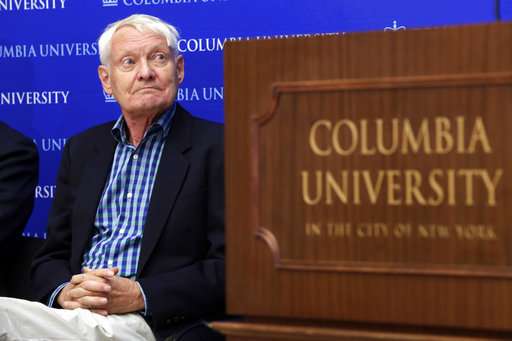
Joachim Frank, of Columbia University, listens to remarks during a Columbia University press conference, Wednesday, Oct. 4, 2017, in New York. Frank shares this year's Nobel Chemistry Prize with two other researchers for developing a method to generate three-dimensional images of the molecules of life. (AP Photo/Richard Drew) -
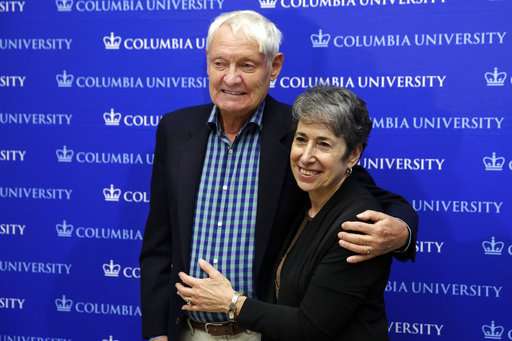
Joachim Frank is hugged by his wife Carol Saginaw, at a Columbia University news conference, Wednesday, Oct. 4, 2017, in New York. Frank shares this year's Nobel Chemistry Prize with two other researchers for developing a method to generate three-dimensional images of the molecules of life. (AP Photo/Richard Drew) -
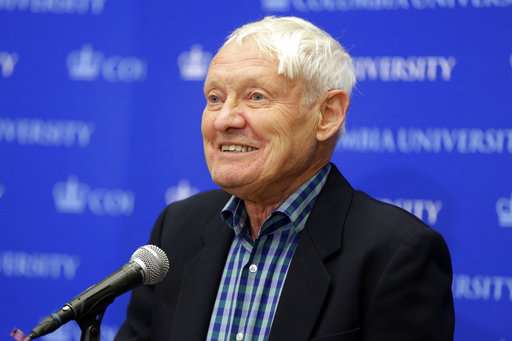
Joachim Frank, of Columbia University, speaks at a Columbia University press conference Wednesday, Oct. 4, 2017, in New York. Frank shares this year's Nobel Chemistry Prize with two other researchers for developing a method to generate three-dimensional images of the molecules of life. (AP Photo/Richard Drew) -
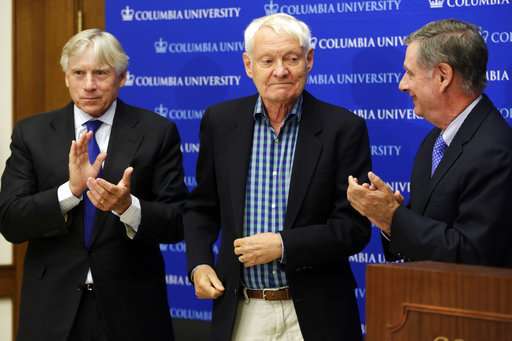
Joachim Frank, center, is applauded by President Lee Bollinger of Columbia University, left, and Lee Goldman, Chief Executive of the Columbia University Medical Center, as he's introduced at a Columbia University press conference, Wednesday, Oct. 4, 2017, in New York. Frank shares this year's Nobel Chemistry Prize with two other researchers for developing a method to generate three-dimensional images of the molecules of life. (AP Photo/Richard Drew)
© 2017 The Associated Press. All rights reserved.





















